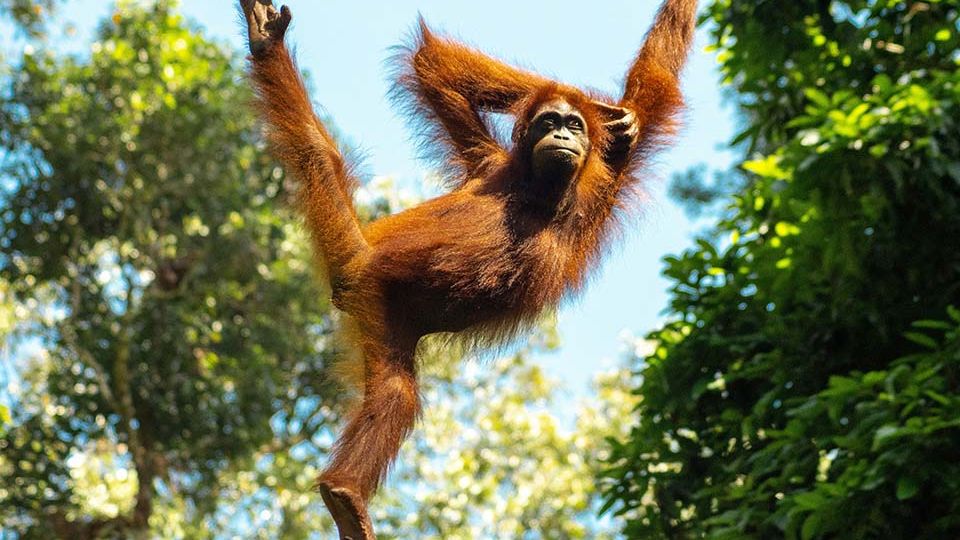August 23, 2024
KOTA KINABALU – Orangutan are thriving in Sabah’s Bukit Piton Forest Reserve, thanks to concerted efforts to conserve the great ape’s habitat between government agencies and the private sector.
Sabah Wildlife Department (SWD) deputy director Roland Oliver Niun said conservation efforts supported by organisations like Yayasan Sime Darby (YSD) at the forest reserve in the Lahad Datu district have significantly increased the usable habitat for orangutans.
He said habitat restoration has been supported through the planting of native species trees, adding it has also accelerated natural forest recovery.
“Now, there is evidence that orangutans are able to travel through, find shelter, and access food resources in areas previously inaccessible to them,” he said, during the International Orangutan Day 2024 in Sandakan.
“This has effectively contributed to Sabah’s achievement of not only having 80% of our orangutans thriving in protected forests but also maintaining their communities connected.
“They make use of these newly restored forests, thus avoiding negative interactions and the need for translocations.
“With YSD’s ongoing support, we will continue to build on these successes and collaboratively address the remaining challenges to ensure the protection of orangutan throughout the region,” Niun said.
He said this during the event that was held in collaboration with the Sabah Forestry Department (SFD) and the SWD at the Rainforest Discovery Centre in Sandakan on Monday (Aug 19).
This year’s in-person event, the first following a virtual celebration in 2021, commemorates 15 years of YSD’s commitment to orangutan conservation.
It spotlights the foundation’s decade-long RM25mil initiative in the Bukit Piton Forest Reserve, formerly known as the Northern Ulu Segama, a key effort in Sabah’s conservation landscape.
The celebration also marks the continuation of YSD’s work with the Human-Orangutan Coexistence (HOC) initiative, now progressing into its second phase with the South East Asia Rainforest Research Partnership (SEARRP).
This initiative illustrates the importance of multi-sector collaboration for effective orangutan conservation in Sabah.
Chief Conservator of Forests Datuk Frederick Kugan said their 10-year partnership with SD Guthrie and YSD has significantly advanced the SFD’s forest conservation technical expertise.
This is, he said, while rehabilitating highly degraded forest which is an important orangutan habitat area in Sabah.
“The successful rehabilitation of the Bukit Piton Forest Reserve has revitalised critical habitats for orangutans and engaged local communities in meaningful ways.
“This initiative is a prime example of how collaborative efforts lead to real change.
“As stewards of Sabah’s natural heritage, our focus remains on applying what we have learned to expand forest conservation across Sabah, safeguarding biodiversity, and enhancing the ecological services that benefit all of Sabah,” Kugan said.
Building on over a decade of efforts, YSD’s support was instrumental in the reclassification of the Northern Ulu Segama as a Class 1 Protection Forest Reserve in 2012.
This was a milestone achieved in coordination with SFD, permanently safeguarding the area from logging and ensuring a fully protected habitat for orangutans.
This success has facilitated the planting of thousands of trees and the rehabilitation of 5,400ha, part of a broader initiative targeting 11,612 hectares of degraded forest, thus establishing a critical sanctuary that now supports nearly 400 orangutans.
The HOC initiative supported by YSD is under the leadership of Dr Felicity Oram, who brings a wealth of experience in orangutan conservation.
This initiative also emphasises the capacity building of local researchers, offering scholarships, comprehensive training, and exposure to ensure sustainable orangutan conservation practices.
The second phase of the HOC initiative will extend scientific monitoring of orangutans across an additional 10,000ha while maintaining the existing monitoring network of 30,000ha established in Phase 1.
YSD chief executive officer Dr Yatela Zainal Abidin said it was heartwarming to see orangutan nests in the thriving trees they planted together in Bukit Piton.
At the same time, she added that their best management practices were adopted in plantation estates, fostering harmony with orangutans.
“I am proud of the orangutan conservation strides we have made since 2010 with various stakeholders in Sabah, especially SFD and SWD.
“Our efforts have rehabilitated highly degraded natural habitats, and we are now focusing on human orangutan coexistence management,” she said.

